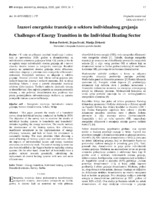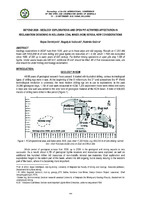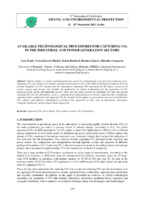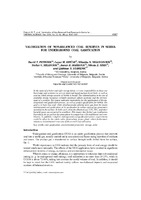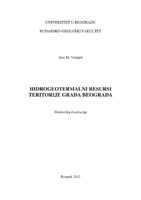Претрага
383 items
-
Testing the energy value of different types of coal by the method of active thermography
In this paper, coal thermograms are presented and analyzed in order to determine their energy value. Two types of coal of different categories, brown and lignite, were selected for active thermographic imaging. The tested coal samples were processed before measurement so that they are similar in dimensions and have two plane-parallel smooth surfaces. The test samples were "primarily" heated under the same conditions and the process of their cooling was monitored by a thermal camera. "Then" they were cooled ...Stevan Đenadić, Ljubiša Tomić, Vesna Damnjanović, Predrag Jovančić, Dragutin Jovković. "Testing the energy value of different types of coal by the method of active thermography" in 9th International Scientific Conference on Defensive Technologies, Belgrade, Serbia, 15-16 October 2020, The Military Technical Institute (2020)
-
Energy Management and Systems of Environmental Safety in Mining-Energy Complexes
Malenović-Nikolić Jelena, Vukadinović Ana, Čokorilo Vojin. "Energy Management and Systems of Environmental Safety in Mining-Energy Complexes" in 5th International Symposium of Mining and Environmental Protection, Belgrade:Faculty of Mining and Geology (2015): 262-267
-
Challenges of Energy Transition in the Individual Heating Sector
U radu su prikazani rezultati istraživanja i ankete koja je sprovedena 2020. godine u domaćinstvima sa individualnim sistemima grejanja u Srbiji. Cilj ankete je bio da se sagleda stanje individualnih sistema grejanja, ali i stavovi vlasnika sistema vezano za energetsku tranziciju. Rezultati ukazuju na zastarelost sistema grejanja, nisku efikasnost, nedovoljna ulaganja u primenu mera energetske efikasnosti i nedostatak finansijskih sredstava za ulaganje u održivo grejanje. Osnovni prioriteti kod izbora načina grejanja jesu troškovi kupovine sistema i troškovi energenta, dok ...Boban Pavlović, Dejan Ivezić, Marija Živković. "Challenges of Energy Transition in the Individual Heating Sector" in Energija, ekonomija, ekologija, University Library in Kragujevac (2022). https://doi.org/10.46793/EEE22-1.17P
-
BEYOND 2020 - Geology explorations and open pit activities affectation in reclamation designing in Kolubara Coal Mines (KCM) Serbia, new considerations
Geology explorations in KCM runs from 1936. year up to these days and still ongoing. Results in >7,200 drill holes with ≈600,000 m of core drilling and gave lignite ore resources of > 4,1Bt, which 1,15Bt are excavated since 1986. of XIX up to early years of XXI century. For further mining operations in open pits stay 1,5Bt of lignite. Under waste heaps are ≈80 km2, additional 85 km2 should be filled. All of that masses/areas were, are ...Bojan Dimitrijević, Bogoljub Vučković, Radmila Gaćina. "BEYOND 2020 - Geology explorations and open pit activities affectation in reclamation designing in Kolubara Coal Mines (KCM) Serbia, new considerations" in 17th International Conference of the open and underwater mining of minerals, Sts. Constantine and Helena Resort, Varna, 18-22 September, Bulgaria, Sofia, Bulgaria : Scientific and Technical Union of Mining, Geology and Metallurgy, (2023)
-
Available technological procedures for capturing CO2 in the industrial and power generation sectors
Climate change is a major environmental issue caused by anthropogenic emissions of greenhouse gases. Capturing CO2 and storing it in suitable geological formations is one of the main technological solutions that can provide mitigation of CO2 emission into the atmosphere. Capturing CO2 represents the first phase in process of carbon capture and storage, and includes the application of various technologies for the separation of CO2 produced in the energy and industrial sectors. There are four main systems for capturing ...... study. Energy Sources, Part A: Recovery, Utilization, and Environmental Effects 2021, doi: 10.1080/15567036.2021.1936303. 4. Leung, D.Y.C.; Caramanna, G.; Maroto-Valer, M.M. An overview of current status of carbon dioxide capture and storage technologies. Renewable and Sustainable Energy Reviews ...
... oxy-fuel combustion [11]. 4. CONCLUSION There are several opportunities to reduce CO2 emissions in energy and industrial sectors such as using natural gas instead of coal, increasing the energy efficiency, and separating CO2 after production using CCS technology which is one of the leading solutions ...
... in oxy-fuel combustion is 80-98% depending on used fossil fuel, but the major drawback is very high capital cost and the energy penalty for the reason that large amount of energy is needed for separating oxygen from the air. Conventional technology procedures that could be employed for capturing CO2 ...Lola Tomić, Vesna Karović Maričić, Dušan Danilović, Branko Leković, Miroslav Crnogorac. "Available technological procedures for capturing CO2 in the industrial and power generation sectors" in 8th International Conference Mining and Environmental Protection, 22 – 25th September 2021, Serbia, Univerzitet u Beogradu, Rudarsko-geološki fakultet (2021)
-
Determining the Impact of Cutting Elements State on the Bucket–Wheel Excavator Vibration and Energy Consumption
Background There are two types of specifc sizes’ measurements. The frst is the measurement of energy consumption in a working technological process, and the second is the measurement of vibration, which is displayed over amplitudes of speed. There is an interplay between these two processes. Increasing the power consumption, the value of the vibration speed amplitudes increases. Purpose The process of the determination of machining parameters was based on minimizing the power consumption and vibration of the cutting tool, ...Filip Miletić, Predrag Jovančić, Miloš Milovančević, Miloš Tanasijević, Stevan Đenadić. "Determining the Impact of Cutting Elements State on the Bucket–Wheel Excavator Vibration and Energy Consumption" in Journal of Vibration Engineering & Technologies, Springer (2022). https://doi.org/10.1007/s42417-022-00482-3
-
Valorization of non-balanced coal reserves in Serbia for underground coal gasification
David Petrović, Lazar Kričak, Milanka Negovanović, Stefan Milanović, Jovan Marković, Nikola Simić, Ljubisav Stamenić (2019)In the name of a better and safer energy future, it is our responsibility to focus our knowledge and activities to save on imported liquid and gas fossil fuels, as well as coal on which energy security of Serbia is based. The rationalization in the use of available energy resources certainly positively affects economy and the environment of a country. This paper indicates motivations for the application of the underground coal gasification process, as well as surface gasification for ...... level of development of this technology. Today's economic, energy and environmental effects have highlighted outstanding, interests for the future of clean and renewable energy resources. While the world is looking at alternative energy resources to meet many of the imposed challenges, fossil fuels ...
... environmental aspect of UCG application in Serbia various additional renewable energy resources have been considered. The key one are solar photovoltaic systems that are proposed to be utilized to provide necessary onsite clean energy generation option [15]. Stand-alone or grid-connected photovoltaic ...
... =713t O, =23400t Capacity – time production of energy m, =1235 t\h m, =10070 mž/h Available energy potential of energy source R =20GWh R,, =25GWh Total value of the obtained energy source C, „=248000 E Cg,„„, =983000 e Working time for energy production T= 120 days = 4 months Potential impacts ...David Petrović, Lazar Kričak, Milanka Negovanović, Stefan Milanović, Jovan Marković, Nikola Simić, Ljubisav Stamenić. "Valorization of non-balanced coal reserves in Serbia for underground coal gasification" in Thermal Science (2019). https://doi.org/10.2298/TSCI190725390P
-
Energetska efikasnost elektromotora na površinskim kopovima
Snežana Aleksandrović, Ilija Jeftenić (2023)Snežana Aleksandrović, Ilija Jeftenić. "Energetska efikasnost elektromotora na površinskim kopovima" in 11. Međunarodna konferencija “Ugalj i kritični materijali" CCM 2023, Zlatibor, 11-14. oktobar 2023. , Beograd : Jugoslovenski komitet za površinsku eksploataciju (2023)
-
Optimising in electrical energy consumption in mining plants
Snežana Aleksandrović, Vesna Damnjanović, Ilija Jeftenić. "Optimising in electrical energy consumption in mining plants" in 17th International Symposium INFOTEH-JAHORINA 2018, Istočno Sarajevo : Elektrotehnički fakultet, Univerzitet u Istočnom Sarajevu (2018)
-
Hidrogeotermalni resursi teritorije grada Beograda
Ana Vranješ (2012-12-12)Republika Srbija je izrazito bogata hidrogeotermalnim resursima. Podzemne vode satemperaturama preko 20oC (pa do 96oC, Vranjska Banja) relativno su dobro iskorišćene.Nasuprot njima, podzemne vode sa temperaturama do 20oC do sada uglavnom nisu bilepredmet istraživanja sa bilo kog aspekta izuzev za potrebe vodosnabdevanja. Razvojemsistema toplotnih pumpi, mogućnosti višenamenskog korišćenja ovih voda značajno suuvećane.Teritorija Beograda odlikuje se značajnim resursima podzemnih voda, pre svega u okvirualuvijalnih peskovito-šljunkovitih naslaga i neogenih tortonsko-sarmatskih krečnjačkihnaslaga. Temperatura ovih voda ne prelazi 25oC. Njihovim zahvatanjem preko istražnoeksploatacionihbunara ...geotermalna energija, hidrogeotermalni resursi, hidrogeotermalni sistemi, hidrogeotermalnapotencijalnost, energetska valorizacija, hidrogeološka rejonizacija, grad BeogradAna Vranješ. "Hidrogeotermalni resursi teritorije grada Beograda" in Универзитет у Београду, Универзитет у Београду, Рударско-геолошки факултет (2012-12-12)
-
The Serbian Geothermal Energy Sector
Ivezić Dejan (2011)Ivezić Dejan. "The Serbian Geothermal Energy Sector" in European Conference – GEOFAR - Innovative Solutions For Geothermal Energy Financing - Proceedings, Atina: (2011)
-
Energy Mining And Sustainable Development
Ristović Ivica (2010)Ristović Ivica. "Energy Mining And Sustainable Development" in Proceedings of 3rd International Symposium ENERGY MINING ER 2010, Belgrade Serbia:FMG, Belgrade (2010): 1-6
-
Industrial Waste Heat Potential for Meeting Heat Demand in the Republic of Serbia
Dejan Ivezić, Marija Živković (2023)Finalna potrošnja energije u industrijskom sektoru čini skoro 25% finalne potrošnje energije u Republici Srbiji. Procenjuje se da je 50-70% potrošnje energije u industriji namenjeno proizvodnji toplotne energije u različitim industrijskim procesima. Deo proizvedene toplotne energije se nepovratno gubi kao energija odvedena u okolinu: prenosom toplote kroz zidove procesne opreme, dimnim gasovim, otpadnim vodama itd. Korišćenjem otpadne toplote povećava se efikasnost korišćenja primarne energije i smanjuje ukupna potreba za energijom. Otpadna toplota se može koristiti u samom industrijskom objektu ...Dejan Ivezić, Marija Živković. "Industrial Waste Heat Potential for Meeting Heat Demand in the Republic of Serbia" in Energija, ekonomija, ekologija (2023). https://doi.org/10.46793/EEE23-1.17I
-
The use of geothermal energy for heating roads and open areas, Serbia, Europe
Milenić Dejan, Vranješ Ana (2014)Milenić Dejan, Vranješ Ana. "The use of geothermal energy for heating roads and open areas, Serbia, Europe" in Proceedings of the Grand Renewable Energy, Tokyo, Japan (2014)
-
Thermal Imaging Assessment of Energy Efficiency
Damnjanović Vesna (2017)Damnjanović Vesna. "Thermal Imaging Assessment of Energy Efficiency" in eNergetics2017, 3rd Virtuel International Conference on Science, Technology and management in Energy 2017, Nis, Srbija:Research and Development Centar “ALFATEC” (2017): 169-172
-
Serbian energy development based on lignite production
Jovančić Predrag, Tanasijević Miloš, Ivezić Dejan. "Serbian energy development based on lignite production" in Energy Policy 39 no. 3, Oxford;UK:Pergamon (2011): 1191-1199. https://doi.org/DOI: 10.1016/j.enpol.2010.11.0
-
The Potential of and Barriers to Renewable Energy Sources in Serbia
Ivezić Dejan, Đajić Nenad, Živković Marija. "The Potential of and Barriers to Renewable Energy Sources in Serbia" in Energy Sources, Part: B Economics Planning and Policy 8 no. 2, USA:Taylor and Francis (2013): 162-170
-
The new Serbian Energy Sector Development Strategy until 2025 and projections until 2030
Ramić Biljana, Ivezić Dejan (2016)Ramić Biljana, Ivezić Dejan. "The new Serbian Energy Sector Development Strategy until 2025 and projections until 2030" in Energy Scenarios for SE Europe: A close look into the Western Balkans, Luxembourg:Publications Office of the European Union (2016): 24-26. https://doi.org/10.2790/337882
-
Serbian oil sector: A new energy policy regulatory framework and development strategies
Karović-Maričić Vesna, Danilović Dušan, Leković Branko. "Serbian oil sector: A new energy policy regulatory framework and development strategies" in Energy Policy no. 51, London-Amsterdam -New York:Elsevier (2012): 311-322
-
Analysis of regulations in the energy sector in Serbia as a support to mitigation and adaptation to climate change
Ivezić Dejan, Živković Marija, Danilović Dušan. "Analysis of regulations in the energy sector in Serbia as a support to mitigation and adaptation to climate change" in International Symposium Sustainable Development of Mining and Energy Industry ORRE11, Beograd:Univerzitet u Beogradu , Rudarsko-geološki fakultet (2011): 317-322

